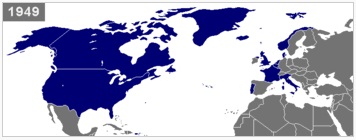|
| |
|
Background Formation Principles Achievements Membership
|
|
|
The North Atlantic Treaty, signed Washington DC, 4 April 1949 The Parties to this Treaty reaffirm their faith in the purposes and principles of the Charter of the United Nations and their desire to live in peace with all peoples and all governments. They are determined to safeguard the freedom, common heritage and civilisation of their peoples, founded on the principles of democracy, individual liberty and the rule of law. They seek to promote stability and well-being in the North Atlantic area. They are resolved to unite their efforts for collective defence and for the preservation of peace and security.
BackgroundTwo years after the Second World War, on 4 March 1947, France and Britain signed the Treaty of Dunkirk, to support each other if either of them should 'become again involved in hostilities with Germany'.
A year later, on 17 March 1948, France and Britain joined with the Belgium, Luxembourg and the Netherlands to sign the Treaty of Brussels. In many ways, this looked like an expansion of the Treaty of Dunkirk. However, there were key differences, inasmuch as the Treaty of Brussels: 1. pledged to ' fortify and preserve the principles of democracy, personal freedom and political liberty'. 2. changed ‘involved in hostilities with Germany’ to ‘an armed attack in Europe’.
So it was clear that, in the Treaty of Brussels, attention had shifted from the danger of Germany to the danger from the Soviet Union. Next month, in April 1948, the Brussels Pact agreed to set up a ‘Western Union Defence Organization’ (WUDO). WUDO was formed in September 1948 (during the Berlin crisis), and in 1949 it held a naval training exercise in the Bay of Biscay involving 60 British, French, and Dutch warships.
The Formation of NATOIt was becoming increasingly clear that no European force would be strong enough to stop the Red Army if Stalin attacked, so in March 1949 the Brussels Pact opened secret negotiations with the Americans, and in April 1949 the North Atlantic Treaty was signed, which set up the North Atlantic Treaty Organisation (NATO).
PrinciplesThe North Atlantic Treaty promised: • To safeguard the freedom, common heritage and civilisation of their peoples, founded on the principles of democracy, individual liberty. • Continuous and effective self-help and mutual aid to maintain and develop their individual and collective capacity to resist armed attack. However, Article 4 stated: • If an armed attack occurs, each of them [will help with] such action as it deems necessary, including the use of armed force. (i.e. they promised to help, but not necessarily to send military aid). • And Article 5 limited the alliance’s operations to the ‘area north of the Tropic of Cancer’ (i.e. the North Atlantic). The Treaty also set up a Council which would meet regularly as necessary. It should be clear from this that the chief aim of NATO was to resist the threat of the Soviet Union, and that - as the words 'continuous and effective' indicated - that this would be a very active, armed resistance.
AchievementsKey achievements have been: 1. 1300 STANAGs (Standardization Agreements), including standardised bullets (so all NATO soldiers can fire the same bullets), aircraft marshalling signals (so any NATO aircraft could land at any NATO base) and the NATO phonetic alphabet. 2. NATO countries participated in the Korean War in 1950-3. 3. The 1952 Lisbon Conference expanded NATO: • it planned the Long-Term Defence Plan. • it set up a permanent force of 35 divisions supported by nuclear weapons. • it set up the post of Secretary General (Baron Hastings Ismay was the first) with the Supreme Headquarters Allied Powers Europe (SHAPE) situated in Paris. 4. Military Exercises: in September 1952, Operation Mainbrace was the first major NATO naval exercise (200 ships practiced defending Denmark and Norway). NATO also held regular army exercises (including practising retreating in good order before overwhelming Soviet forces). 5. The Clandestine Planning Committee (CPC) planned guerrilla resistance in any country which might be conquered by the Soviets ('Operation Gladio'). 6. In 1962, NATO countries were on standby during the Cuban Missiles crisis.
Membership1. Originally, NATO consisted of 12 members: Belgium, Canada, Denmark, France, Iceland (did not have an army, by did have a good strategic geographic position in the Atlantic), Italy, Luxembourg, Netherlands, Norway, Portugal, Britain and the USA.
2. Greece and Turkey joined the alliance in 1952. 3. In 1954, the Soviet Union tried to join NATO, but was turned down. 4. Instead, on 9 May 1955, NATO brought West Germany into NATO – it was this act which provoked the Soviet Union to form the Warsaw Pact (1955).
5. On 11 March 1959, France complained the Britain and the USA had too much influence within NATO, and withdrew its Fleet from NATO command. In 1966 France withdrew all its armed forces from NATO, and all NATO troops and SHAPE were asked to leave France.
|
|
|
| |
 NATO in 1949
NATO in 1949 NATO in 1955
NATO in 1955